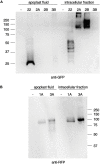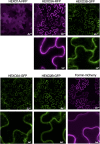β-Hexosaminidases Along the Secretory Pathway of Nicotiana benthamiana Have Distinct Specificities Toward Engineered Helminth N-Glycans on Recombinant Glycoproteins
- PMID: 33815445
- PMCID: PMC8010188
- DOI: 10.3389/fpls.2021.638454
β-Hexosaminidases Along the Secretory Pathway of Nicotiana benthamiana Have Distinct Specificities Toward Engineered Helminth N-Glycans on Recombinant Glycoproteins
Abstract
Secretions of parasitic worms (helminths) contain a wide collection of immunomodulatory glycoproteins with the potential to treat inflammatory disorders, like autoimmune diseases. Yet, the identification of single molecules that can be developed into novel biopharmaceuticals is hampered by the limited availability of native parasite-derived proteins. Recently, pioneering work has shown that helminth glycoproteins can be produced transiently in Nicotiana benthamiana plants while simultaneously mimicking their native helminth N-glycan composition by co-expression of desired glycosyltransferases. However, efficient "helminthization" of N-glycans in plants by glyco-engineering seems to be hampered by the undesired truncation of complex N-glycans by β-N-acetyl-hexosaminidases, in particular when aiming for the synthesis of N-glycans with antennary GalNAcβ1-4GlcNAc (LacdiNAc or LDN). In this study, we cloned novel β-hexosaminidase open reading frames from N. benthamiana and characterized the biochemical activity of these enzymes. We identified HEXO2 and HEXO3 as enzymes responsible for the cleavage of antennary GalNAc residues of N-glycans on the model helminth glycoprotein kappa-5. Furthermore, we reveal that each member of the HEXO family has a distinct specificity for N-glycan substrates, where HEXO2 has strict β-galactosaminidase activity, whereas HEXO3 cleaves both GlcNAc and GalNAc. The identification of HEXO2 and HEXO3 as major targets for LDN cleavage will enable a targeted genome editing approach to reduce undesired processing of these N-glycans. Effective knockout of these enzymes could allow the production of therapeutically relevant glycoproteins with tailor-made helminth N-glycans in plants.
Keywords: LacdiNAc; N-glycosylation; Nicotiana benthamiana; glyco-engineering; β-hexosaminidases.
Copyright © 2021 Alvisi, van Noort, Dwiani, Geschiere, Sukarta, Varossieau, Nguyen, Strasser, Hokke, Schots and Wilbers.
Conflict of interest statement
The authors declare that the research was conducted in the absence of any commercial or financial relationships that could be construed as a potential conflict of interest.
Figures






Similar articles
-
Glyco-Engineering Plants to Produce Helminth Glycoproteins as Prospective Biopharmaceuticals: Recent Advances, Challenges and Future Prospects.Front Plant Sci. 2022 Apr 29;13:882835. doi: 10.3389/fpls.2022.882835. eCollection 2022. Front Plant Sci. 2022. PMID: 35574113 Free PMC article. Review.
-
Reduced paucimannosidic N-glycan formation by suppression of a specific β-hexosaminidase from Nicotiana benthamiana.Plant Biotechnol J. 2017 Feb;15(2):197-206. doi: 10.1111/pbi.12602. Epub 2016 Aug 11. Plant Biotechnol J. 2017. PMID: 27421111 Free PMC article.
-
Enzymatic properties and subcellular localization of Arabidopsis beta-N-acetylhexosaminidases.Plant Physiol. 2007 Sep;145(1):5-16. doi: 10.1104/pp.107.101162. Epub 2007 Jul 20. Plant Physiol. 2007. PMID: 17644627 Free PMC article.
-
Production and glyco-engineering of immunomodulatory helminth glycoproteins in plants.Sci Rep. 2017 Apr 10;7:45910. doi: 10.1038/srep45910. Sci Rep. 2017. PMID: 28393916 Free PMC article.
-
Glycan gimmickry by parasitic helminths: a strategy for modulating the host immune response?Glycobiology. 2010 Jan;20(1):2-12. doi: 10.1093/glycob/cwp140. Epub 2009 Sep 11. Glycobiology. 2010. PMID: 19748975 Review.
Cited by
-
Genome-Wide Identification of a Maize Chitinase Gene Family and the Induction of Its Expression by Fusarium verticillioides (Sacc.) Nirenberg (1976) Infection.Genes (Basel). 2024 Aug 17;15(8):1087. doi: 10.3390/genes15081087. Genes (Basel). 2024. PMID: 39202446 Free PMC article.
-
Anti-Inflammatory Effects of Helminth-Derived Products: Potential Applications and Challenges in Diabetes Mellitus Management.J Inflamm Res. 2024 Dec 28;17:11789-11812. doi: 10.2147/JIR.S493374. eCollection 2024. J Inflamm Res. 2024. PMID: 39749005 Free PMC article. Review.
-
Analysis of carbohydrates and glycoconjugates by matrix-assisted laser desorption/ionization mass spectrometry: An update for 2021-2022.Mass Spectrom Rev. 2025 May-Jun;44(3):213-453. doi: 10.1002/mas.21873. Epub 2024 Jun 24. Mass Spectrom Rev. 2025. PMID: 38925550 Free PMC article. Review.
-
Recent Developments in Deciphering the Biological Role of Plant Complex N-Glycans.Front Plant Sci. 2022 Apr 25;13:897549. doi: 10.3389/fpls.2022.897549. eCollection 2022. Front Plant Sci. 2022. PMID: 35557740 Free PMC article. Review.
-
Glyco-Engineering Plants to Produce Helminth Glycoproteins as Prospective Biopharmaceuticals: Recent Advances, Challenges and Future Prospects.Front Plant Sci. 2022 Apr 29;13:882835. doi: 10.3389/fpls.2022.882835. eCollection 2022. Front Plant Sci. 2022. PMID: 35574113 Free PMC article. Review.
References
LinkOut - more resources
Full Text Sources
Other Literature Sources

